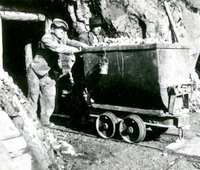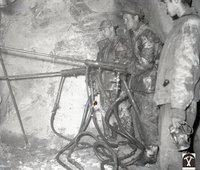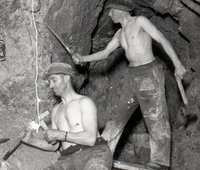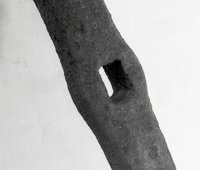Drifting
In older times, mines were dug by hand (corridors dug in this way are called “kresanice”), which was slow work. The drifting speed even decreased with the increasing length of the adit (mainly due to insufficient ventilation and cramped spaces). The adit was not dug straight like a tunnel, but in a zigzag fashion - it followed fissures with softer rock and, if possible, an ore-bearing dike. It is estimated that when the year was successful, 15 meters of adits were dug. On the other hand, if it didn't work out, it could be less than five meters, and in turbulent times of wars, rebellions or during epidemics, work was even completely interrupted for many years. The mining lesson says that the smaller the cross-section of the corridor, the older it is. Former mines were not similar to the spacious ones of today. The miners worked with only the simplest tools – hammer and moyle – in a very tight space, often kneeling or crouching, in a windless environment and with poor lighting. Currently, various drifting machines are used for drifting the corridors in the mine.
Ore disintegration
In prehistoric times, tools made of bones, animal antlers and worked stones – flake tool, were used to disintegrate ores. Metal processing and its use became a milestone in the development of work tools. The stone fist wedge was replaced by an iron wedge - moyle. In the 12th century, the use of moyle, hammer and other tools is known. The physically demanding work was made easier by the use of black gunpowder, which was used for military purposes until then. For the first time in the world, it was used in mining for the disintegration of ore in Horná Bieber adit in Štiavnické Bane (Piarg). In the 19th century, various mechanical drilling equipment began to be used in mining to disintegrate ores. The machines were attached to stands and drilling was done with steel drills with different endings.
Transportation
Transportation of people and material. Different types of ladders were mainly used in vertical passenger transport. The material was carried out in buckets and in leather bags (rich ore) and was pulled out by using winches and capstanes. In the underground, the material is transported in smaller quantities in troughs, various baskets, which are pulled using a rope. Underground, the material was transported in smaller quantities in troughs, various baskets, which are pulled by using a rope. With the increase in the number of mined ore, the transport of these materials had to be adapted, and different wheelbarrows and different types of carts were created that drove on wooden tracks. Iron rails have been used since the beginning of the 19th century. The first underground horse railway was established in the years 1825-28 in the Holy Trinity heritage adit in Banská Štiavnica.





